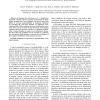Free Online Productivity Tools
i2Speak
i2Symbol
i2OCR
iTex2Img
iWeb2Print
iWeb2Shot
i2Type
iPdf2Split
iPdf2Merge
i2Bopomofo
i2Arabic
i2Style
i2Image
i2PDF
iLatex2Rtf
Sci2ools
ICPR
2010
IEEE
2010
IEEE
The Balanced Accuracy and Its Posterior Distribution
—Evaluating the performance of a classification algorithm critically requires a measure of the degree to which unseen examples have been identified with their correct class labels. In practice, generalizability is frequently estimated by averaging the accuracies obtained on individual crossvalidation folds. This procedure, however, is problematic in two ways. First, it does not allow for the derivation of meaningful confidence intervals. Second, it leads to an optimistic estimate when a biased classifier is tested on an imbalanced dataset. We show that both problems can be overcome by replacing the conventional point estimate of accuracy by an estimate of the posterior distribution of the balanced accuracy. Keywords-classification performance; generalizability; bias; class imbalance
Computer Vision | Conventional Point Estimate | Correct Class Labels | ICPR 2010 | Meaningful Confidence Intervals |
| Added | 07 Dec 2010 |
| Updated | 07 Dec 2010 |
| Type | Conference |
| Year | 2010 |
| Where | ICPR |
| Authors | Kay Henning Brodersen, Cheng Soon Ong, Klaas Enno Stephan, Joachim M. Buhmann |
Comments (0)

